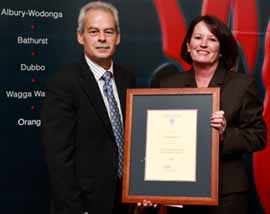The smell of smoke and the feel of ash, heat and water may be absent but virtual fire scenes have been given the thumbs up in improving the fire investigation skills of Charles Sturt University (CSU) students.
Faced with a number of challenges creating an uncontaminated real time fire scene for students, the University harnessed the virtual environment in 2007 for a fire investigation subject taught through the School of Policing Studies at CSU at Goulburn.
“The students – many of them early career fire investigators studying by distance education – are able to explore a series of real life fire scene images by zooming, panning or tilting in a CD learning resource,” said CSU lecturer Ms Amanda Davies.
“An evaluation of the subject Fire Investigation Cause and Origin focussed on four different student groups in 2008, with a particular focus on whether the absence of sensory or tactile elements like smoke and vapour affected their learning outcomes.
“We found that the absence of tactile elements in the virtual environment does not inhibit the students’ ability to successfully investigate the virtual burn scene and determine the cause and origin of a structural fire.
“We actually found that there are benefits to student learning in the virtual environment, including less distraction from the noise and damage, unrestricted access to an uncontaminated scene and the ability of the student to repeatedly revisit the site.”
 Ms Davies’ outstanding contribution to student learning through the development of the fire investigation subject has been honoured by the Australian Learning and Teaching Council (ALTC). Ms Davies will receive a prestigious ALTC citation in Canberra in August for “innovation, enthusiasm, commitment, and quality in teaching and learning practices for police recruits, fire investigators and academics”.
Ms Davies’ outstanding contribution to student learning through the development of the fire investigation subject has been honoured by the Australian Learning and Teaching Council (ALTC). Ms Davies will receive a prestigious ALTC citation in Canberra in August for “innovation, enthusiasm, commitment, and quality in teaching and learning practices for police recruits, fire investigators and academics”.The CSU academic was also recognised at a national conference for the simulation community, SimTech 2009 in Adelaide in June. Ms Davies’ evaluation of the fire investigation subject, co-authored by CSU academic Dr Barney Dalgarno, was named as the best paper by a PhD student.
“For others involved in the development of simulated virtual environments for training purposes the evaluation shows that maximising the fidelity or realism of the simulated environment may not in fact be desirable,” Ms Davies said.
“Sooner or later learners need to be provided with the opportunity to practice their skills in a real life context, however, during the learning stage, there are strong arguments for the provision of scaffolded learning environments that include the most important elements of the real environment but not so many of the characteristics as to overwhelm a student during learning.”
Ms Davies recently received an internal CSU honour for her work in the School of Policing Studies. CSU Vice-Chancellor and President Professor Ian Goulter presented her with the 2009 Vice-Chancellor’s Award for Teaching Excellence in a ceremony at CSU at Bathurst on Tuesday 30 June.





Social
Explore the world of social